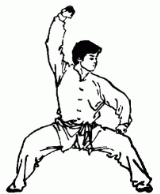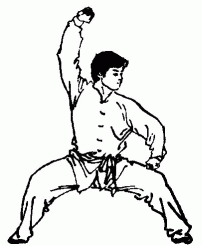
Horse stance
Encyclopedia
The horse stance is an important posture in Asian martial arts and takes its name from the position assumed when riding a horse
. It is called mǎbù (馬步) in Chinese
, in Japanese
, kekuda or kuda-kuda in Malay
, asvavadivu in Malayalam, and juchum seogi or annun seogi (lit. sitting stance) in Korean
. This stance can not only be integrated into fighting but also during exercises and forms
. It is most commonly used for practicing punches or to strengthen the legs and back.
 Several Chinese training methods have students stand in mabu while performing the required tasks or exercises. Mabu is used for endurance training
Several Chinese training methods have students stand in mabu while performing the required tasks or exercises. Mabu is used for endurance training
as well as strengthening the back and leg muscles, tendon strength, and overall feeling and understanding of "feeling grounded".
There are five main Horse Stances used in Shaolin kungfu:
See also Wushu Stances
for more information.
In Northern Shaolin
, the distance between the feet is measured by placing a fist and the lower leg on the ground. A relatively narrow posture was assumed for the horse riding stance.
While most southern Chinese styles (such as Hung Gar
) are known for their deep and wide horse stance, other forms such as Wing Chun
have a narrower, higher horse stance, with the feet almost pigeon toe
d.
 In Japanese martial arts
In Japanese martial arts
, the horse stance (kiba-dachi) has many minor variations between individual schools, including the distance between the feet, and the height of the stance. One constant feature is that the feet must be parallel to each other.
Note that the horse stance differs from the , widely used in sumo
, in which the feet point outward at 45 degrees rather than being parallel.
Horse
The horse is one of two extant subspecies of Equus ferus, or the wild horse. It is a single-hooved mammal belonging to the taxonomic family Equidae. The horse has evolved over the past 45 to 55 million years from a small multi-toed creature into the large, single-toed animal of today...
. It is called mǎbù (馬步) in Chinese
Chinese language
The Chinese language is a language or language family consisting of varieties which are mutually intelligible to varying degrees. Originally the indigenous languages spoken by the Han Chinese in China, it forms one of the branches of Sino-Tibetan family of languages...
, in Japanese
Japanese language
is a language spoken by over 130 million people in Japan and in Japanese emigrant communities. It is a member of the Japonic language family, which has a number of proposed relationships with other languages, none of which has gained wide acceptance among historical linguists .Japanese is an...
, kekuda or kuda-kuda in Malay
Malay language
Malay is a major language of the Austronesian family. It is the official language of Malaysia , Indonesia , Brunei and Singapore...
, asvavadivu in Malayalam, and juchum seogi or annun seogi (lit. sitting stance) in Korean
Korean language
Korean is the official language of the country Korea, in both South and North. It is also one of the two official languages in the Yanbian Korean Autonomous Prefecture in People's Republic of China. There are about 78 million Korean speakers worldwide. In the 15th century, a national writing...
. This stance can not only be integrated into fighting but also during exercises and forms
Kata
is a Japanese word describing detailed choreographed patterns of movements practised either solo or in pairs. The term form is used for the corresponding concept in non-Japanese martial arts in general....
. It is most commonly used for practicing punches or to strengthen the legs and back.
Chinese martial arts

Zhan zhuang
Zhan zhuang is a method of training in many Chinese martial arts in which static postures are used for physical training, to develop efficiency of movement, perfection of structural alignment; and hence maximal strength, for martial applications....
as well as strengthening the back and leg muscles, tendon strength, and overall feeling and understanding of "feeling grounded".
There are five main Horse Stances used in Shaolin kungfu:
- Front Horse (Horse Stance): A wide low stance, legs to the side, used to build up the back.
- Straight horse: A long, low stance, should not be able to see toes; used to prevent being swept, and also used to advance when striking. Also called bow stance.
- Hanging Horse: Used for retreating when there is no room usually, can be used for blocking then going to advance strike.
- Cross Horse: Used for parrying usually. Also called cat stance.
- Drop Horse: Similar to the Straight Horse, except used to duck. Like the Hanging horse, the weight is on the back leg.
See also Wushu Stances
Wushu Stances
Stances are a highly fundamental part of all Chinese Martial Arts. Wushu is characterized by low, wide stances designed for mobility and protection. Stability is another key concern of Chinese martial arts, and the wushu stances reflect this sensibility. There are five key stances utilized in both...
for more information.
Northern styles
The ideal horse stance in most northern Chinese martial arts (such as Mizongquan, My Jhong Law Horn and Jia Men/Chaquan) will have the feet pointed forward, thighs parallel to the floor, with the buttocks pushed out, and the back "arched up" to keep the upper body from leaning forward. The emphasis on this latter point will vary from school to school as some schools of Long Fist, such as Tai Tzu and Bajiquan, will opt for the hips forward, with the buttocks "tucked in."In Northern Shaolin
Shaolin kung fu
Shaolin Kung Fu refers to a collection of Chinese martial arts that claim affiliation with the Shaolin Monastery.Of the multitude styles of kung fu and wushu, only some are actually related to Shaolin...
, the distance between the feet is measured by placing a fist and the lower leg on the ground. A relatively narrow posture was assumed for the horse riding stance.
Southern Shaolin
In Southern Shaolin, a wide horse riding stance is assumed as if riding a horse. The reason for this is that southern Chinese martial arts were designed to be used whilst fighting on boats and barges. The wide posture was created for greater stability in such conditions. The horse stance in southern Chinese systems is commonly done with the thighs parallel to the ground and the toes pointing forward or angled slightly out.While most southern Chinese styles (such as Hung Gar
Hung Gar
Hung Ga 洪家, Hung Kuen 洪拳, or Hung Ga Kuen 洪家拳 is a southern Chinese martial art associated with the Chinese folk hero Wong Fei Hung, who was a master of Hung Ga....
) are known for their deep and wide horse stance, other forms such as Wing Chun
Wing Chun
Wing Chun , also romanised as Ving Tsun or Wing Tsun, ; ; is a concept-based Chinese martial art and form of self-defense utilizing both striking and grappling while specializing in close-range combat.The alternative characters 永春 "eternal spring" are also...
have a narrower, higher horse stance, with the feet almost pigeon toe
Pigeon toe
Pigeon toe, also called metatarsus varus, metatarsus adductus, in-toe gait, intoeing or false clubfoot, is a condition which causes the toes to point inward when walking...
d.
Japanese martial arts

Japanese martial arts
Japanese martial arts refers to the enormous variety of martial arts native to Japan. At least three Japanese terms are often used interchangeably with the English phrase "Japanese martial arts": , literally meaning "martial way", , which has no perfect translation but means something like science,...
, the horse stance (kiba-dachi) has many minor variations between individual schools, including the distance between the feet, and the height of the stance. One constant feature is that the feet must be parallel to each other.
Note that the horse stance differs from the , widely used in sumo
Sumo
is a competitive full-contact sport where a wrestler attempts to force another wrestler out of a circular ring or to touch the ground with anything other than the soles of the feet. The sport originated in Japan, the only country where it is practiced professionally...
, in which the feet point outward at 45 degrees rather than being parallel.

